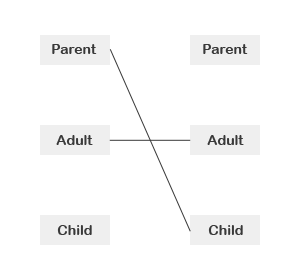Please Note: This is the companion blog post to a section I did on Explicit Web in Episode 6. This topic is possibly easier to digest in audio form, so I highly recommend you have a listen!
 Nightmare clients: We've all had them.
Nightmare clients: We've all had them.
They come in all shapes & sizes: needy ones, demanding ones, ones that know too much, ones that know too little, ones that don't call, ones that don't pay, and all making our lives a more difficult that we'd like them to be. Using "Transactional Analysis" I'm going to help you figure out what's going wrong and perhaps set things straight with those problematic client relationships.
The phrase "problematic client relationship" was chosen very carefully. I don't doubt for a second that your nightmare client is being difficult, but I also believe that it's far harder to change their behaviour than it is to change your own. More importantly, the key is to realise that the problem between you and your client lies in the relationship between you and your client. By changing the relationship, you can resolve your differences without ever having to directly confront them.
Transactional Analysis
Before you close the page because of the scary psycho-babble term, WAIT! It's just a posh name for a really clever, yet simple premise that WILL MAKE YOUR LIFE EASIER. Please bear with me whilst I attempt to explain it in as few words as possible then I'll cut to the fun stuff with examples. Transactional Analysis (TA) theory says that when ever two people communicate, they do so whilst acting in one of three roles: parent, adult or child. These aren't actual parents, adults and children, they are concepts: e.g. a parent assumes authority & takes a lot of responsibility, a child accepts the authority of others and takes very little responsibility and an adult is the "grown-up" happy middle ground. A parent and child can successfully communicate (although it's not always appropriate) and so can two adults, but any other pairing would likely result in communication breakdown.
Transactional Analysis (TA) theory says that when ever two people communicate, they do so whilst acting in one of three roles: parent, adult or child. These aren't actual parents, adults and children, they are concepts: e.g. a parent assumes authority & takes a lot of responsibility, a child accepts the authority of others and takes very little responsibility and an adult is the "grown-up" happy middle ground. A parent and child can successfully communicate (although it's not always appropriate) and so can two adults, but any other pairing would likely result in communication breakdown.
Most communication should be done adult to adult. When one person starts out or inadvertantly slips from adult into the parent or child role, it causes communication to become strained, or worse can force the other person to reactively slip into the opposite role. This can be a source of major frustration and difficulty for either party.
TA's core principle is that whenever there is a breakdown in communication, it can always be attributed to one or the other parties acting in an inappropriate role for the situation. Applying this to the service provider - client relationship, communication should always be adult to adult. Each party on equal terms, consulting and working together to achieve a common goal. With that in mind, let's analyse some typical scenarios.
Classic Clients
Have a read through these classic client scenarios and see if you can figure out what the cause of the breakdown in communication is according to TA. I explain my thoughts below, but they're all open to interpretation!
Classic Client 1: You get an email from a client, containing a vague brief for a 5 page website. After asking for some more detail, they reply they aren't too sure, can they pay you to sort it all out? After all you're the professional! You take on the job, hire a copywriter & are really enjoying having the freedom to express yourself on a project. 2 weeks before launch , you receive and email from the client saying: "We're really sorry, but we've changed our minds, we don't like the website any more. It just really isn't what we had in mind."
Classic Client 2: You get an email from a client, containing a detailed brief for a new website. You agree to work with them and set about designing the site. You show the client what is your best design yet, you're really happy with it and they are too, only they want to make a few minor amends. You concede, after all it's only a few tiny changes. You start the build stage, and receive a couple of requests for further "5 minute amends", again they're only small so you oblige. A few weeks before launch the client sees a near-complete working example and provides some feedback: "In my head the latest news block was going to scroll, oh and can we change the headers to be large, bold, red, and comic sans?".
"...whenever there is a breakdown in communication, it can always be attributed to one or the other parties acting in an inappropriate role for the situation."
My thoughts
Classic Client 1: This client is clearly not willing to take on any responsibility or authority for their project i.e. acting in the "child" role. I'd guess that their initial decision to be uninvolved made them feel less able to communicate their own thoughts later on, only communicating when it became obvious that they were going to have to pay for something that didn't meet their expectations. The service provider was almost tricked into assuming responsibility, I mean who wouldn't jump at the opportunity to have free reign over a project?
Classic Client 2: Slowly over the course of the project, this client has grown accustomed to getting their own way, to being the "parent" or "authority". Now they expect changes they request to be carried out and the service provider is feeling unable to communicate their objections. This gradual change of roles is really hard to detect & is a great example of the frustation that is felt by the "child".
In Conclusion...
So what have we learnt from this exercise? Using TA we have an excellent tool for analysing our relationships and determining the root cause of a communication problem. However determining the cause is only half the story - we can also infer from TA how to go about resolving communication breakdowns.If the problem is caused by slipping out of the appropriate "adult" role then clearly the resolution is to retake the correct role. In the same way that one party adopting the parent role can force the other to react in the child role, it should be possible to maintain the adult role and coerce your client to respond in kind. This principle should guide your actions but does require skill and good judgement.
It is far harder to apply the principles of TA "after the fact" - what it is better at, is prevention. Educating your clients throughout your relationship as to what should be expected from each of you is a great way to help ensure your client holds up their end of the bargain. I tend to find that life is full of little slips, where one or other person in a communication slips into the wrong role temporarily. TA allows us to identify and recover from these slips much more quickly, averting disaster.
Client: “You need to learn how to run a business. You fucking kids don’t know anything, and just want to rip all us honest business people off.” Clients from Hell
Finally, there is just no accounting for some people (I recommend a visit to the Clients from Hell blog). Sometimes we have to execute disaster avoidance - if a new client approaches you acting as parent or child, and one or two carefully worded communications doesn't resolve the problem, then cut your losses or resolve yourself to a nightmare project. Some client relationships are best solved by not having them at all.
Relevant & Related Writings
- Avoiding nightmare clients - John O'Nolan
- Educating Clients to say Yes - Boag World
- Educating your client on web development successfully. - Smashing Magazine
- The importance of teaching your clients and being the boss - Sam Brown